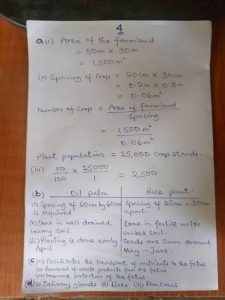
AGRIC OBJ
01-10: BCBAACBDDB
11-20: DBCAACACAD
21-30: CDCCAADCAA
31-40: ACDADDABBD
41-50: BBACCAADCB
COMPLETED
WAEC GCE AGRICULTURAL SCIENCE ESSAY
NUMBER ONE
(1ai)
Finance:
(i) Limited access to credit inhibits farmers’ ability to invest in inputs and equipment.
(ii) High interest rates increase the cost of borrowing, making it difficult for farmers to obtain necessary funds.
(iii) Insufficient financial resources restrict farmers’ capacity to adopt modern agricultural practices.
(iv) Inadequate capital limits the ability to purchase improved seeds, fertilizers, and machinery.
(1aii)
Storage facilities:
(i) Lack of proper storage infrastructure leads to post-harvest losses due to spoilage and pests.
(ii) Inadequate storage facilities restrict farmers’ ability to store and market their produce effectively.
(iii) Insufficient cold storage facilities limit the accessibility of perishable goods, reducing their market value.
(iv) Poor storage capacity hampers the ability to benefit from seasonal price fluctuations and engage in value-added activities like processing.
(1bi)
Farm planning is the process of designing and organizing various operations and activities on a farm to maximize productivity, efficiency, and sustainability.
(1bii)
(PICK FOUR ONLY)
(i) Land availability and suitability for farming.
(ii) Access to water sources for irrigation and livestock.
(iii) Climate and weather patterns affecting crop growth and animal welfare.
(iv) Market demand for the selected crops or livestock products.
(v) Availability and cost-effectiveness of farming inputs such as seeds, fertilizers, and equipment.
(vi) Farm management skills and labor availability.
(vii) Environmental sustainability and conservation practices.
(viii) Economic viability and financial planning for the farm business.
(1c)
(PICK FOUR ONLY)
(i) Effective farm planning helps determine the optimal allocation of resources such as land, labor, and capital for maximum productivity.
(ii) Farm planning ensures efficient utilization of available land by considering factors like crop rotation, soil health, and suitable production systems.
(iii) It facilitates the development of realistic production goals and targets for the farm.
(iv) Farm planning aids in mitigating risks associated with fluctuating market conditions and environmental uncertainties.
(v) It enables the adoption of sustainable farm practices by promoting conservation measures and the use of renewable resources.
(vi) Effective farm planning allows for the optimization of input use, minimizing wastage and reducing expenses.
(vii) It helps in the diversification of farm enterprises, leading to increased income streams and enhanced resilience to market fluctuations.
(viii) Farm planning promotes long-term strategic decision-making, facilitating the development and growth of the farm enterprise.
(2ai)
Symbiotic Nitrogen Fixation:
(i) Through the association of leguminous plants with nitrogen-fixing bacteria in root nodules.
(ii) Through the association of non-leguminous plants with nitrogen-fixing bacteria in specialized structures.
(2aii)
Electrical Discharge:
(i) Through lightning strikes, which convert atmospheric nitrogen into nitrate or nitrite.
(ii) Through electrochemical reactions in the soil, converting atmospheric nitrogen into ammonium ions.
(2aiii)
Ammonification:
(i) Through the decomposition of organic matter by soil microorganisms, releasing ammonium ions.
(ii) Through the breakdown of proteins and urea present in animal waste, releasing ammonium ions.
(2bi)
Monocotyledonous crops have a single seed leaf while dicotyledonous crops have two seed leaves.
(2bii)
(I) Monocotyledonous crops:
(i) Rice
(ii) Corn
(iii) Wheat
(II) Dicotyledonous crops:
(i) Soybean
(ii) Cotton
(iii) Tomato
(2c)
(PICK FOUR ONLY)
(i) Excessive use of synthetic fertilizers.
(ii) Overgrazing by livestock.
(iii) Deforestation and land clearing.
(iv) Poor irrigation and water management practices.
(v) Improper crop rotation and monoculture planting.
(vi) Soil erosion due to improper tilling and land management.
(vii) Heavy pesticide and herbicide use.
(viii) Inadequate waste management and disposal of agricultural by-products.
(3a)
(i) Green Manure:
Green manure refers to crops or plants, such as legumes or cover crops, grown and plowed into the soil while still green, adding organic matter, improving soil structure, and enhancing nutrient content.
(ii) Farmyard Manure:
Farmyard manure consists of organic materials like animal dung, bedding, and other farm residues that undergo decomposition, providing essential nutrients and improving soil fertility when applied to farmland.
(iii) Compost:
Compost is a type of organic manure produced through the decomposition of organic waste materials, including kitchen scraps and plant residues, resulting in a nutrient-rich, humus-like material that improves soil structure and fertility.
(3bi) Advantages of Mixed Farming:
(PICK ANY THREE)
(i) Diversification of Income Sources.
(ii) Enhanced Nutrient Cycling and Soil Fertility.
(iii) Risk Reduction through Crop-Livestock Integration.
(iv) Efficient Utilization of Resources.
(v) Increased Resilience to Market Fluctuations.
(3bii) Disadvantages of Mixed Farming:
(PICK ANY THREE)
(i) Complexity in Management and Planning.
(ii) Potential for Disease Transmission Between Crops and Livestock.
(iii) Competition for Limited Resources.
(iv) Skill Intensiveness in Managing Different Enterprises.
(v) Market Risks Associated with Varied Agricultural Products.
(3ci)
Fishery regulations are rules and guidelines established by government authorities to manage and control fishing activities, ensuring sustainable exploitation of fishery resources and conservation of aquatic ecosystems.
(3cii)
(PICK ANY FOUR)
(i) Ban on the use of toxic chemicals/poisons
(ii) Landing tax is paid based on the total catch and sizes of fish at landing sites
(iii) Fishing areas are allocated to individual fishermen so as to curb indiscriminate interference within the large fishing areas
(iv) No vessels (except canoes) shall fish within the first two nautical miles of the territorial waters a country’s continental shelf
(v) No person shall operate or navigate any motorised fishing boat within the territorial water of other country unless a license in respect of that vessel has been issued
(vi) Identified breeding section of water is normally restricted from fishing
(vii) Fishing activities is restricted during rainy season
(viii) The use of prescribed mesh size in fishing to protect young fish
(ix) Ban on the discharge of pollutants or toxic materials into a country’s terririal water
(x) Ban on the use of explosives in fishing except for the purpose of research
(xi) Ban on the use of electric fishing except for the purpose of research
(xii) Coastal areas to be constantly under surveillance to restrict foreign vessels from exploitation
NUMBER 4

NUMBER FIVE
(5ai)
Artificial insemination refers to the process of introducing sperm into the reproductive system of a female animal without natural mating. This is commonly used in animal breeding to facilitate controlled and selective breeding.
(5aii)
(PICK ANY FIVE)
(i) Artificial insemination can be expensive due to the need for specialized equipment and trained professionals.
(ii) Conception rates with artificial insemination are generally lower compared to natural mating, as there can be challenges in properly timing the insemination.
(iii) Artificial insemination can increase the risk of spreading sexually transmitted diseases if proper hygiene and disinfection protocols are not followed.
(iv) Artificial insemination can lead to a reduction in genetic diversity, as the same few males may be used for breeding repeatedly.
(v) Artificial insemination requires trained professionals who possess the necessary skills and knowledge to perform the procedure correctly.
(vi) The equipment used in artificial insemination requires regular maintenance and calibration, which adds to the overall cost and complexity.
(vi) Artificial insemination bypasses the natural mating process, which can have negative effects on the natural behaviors and instincts of the animals.
(5b)
(PICK ANY FIVE)
(i) Farmers
(ii) Rural communities
(iii) Farming cooperatives and organizations
(iv) Youth in agriculture
(v) Women in agriculture
(vi) Agribusinesses
(vii) Government agencies
(5ci)
(i) Natural water sources
(ii) Artificial water sources
(5cii)
(PICK ANY FOUR)
(i) Hydration
(ii)Temperature regulation
(iii) Digestion
(iv) Milk production
(v) Cleanliness and hygiene
(vi) Disease prevention
NUMBER SIX
(6ai)
Agricultural insurance is a type of insurance policy designed to protect farmers and agricultural businesses against potential financial losses caused by various perils and risks associated with farming activities.
(6aii)
(PICK FIVE ONLY)
(i) Limited accessibility and availability of agricultural insurance products and services.
(ii) Insufficient knowledge and awareness about agricultural insurance among farmers.
(iii) Inadequate data and information infrastructure for risk assessment and product development.
(iv) Inadequate premium pricing and risk classification methodologies.
(v) Challenges related to fraud and moral hazard in agricultural insurance.
(vi) Insufficient capacity building and training for insurance professionals and farmers.
(vii) Limited financial and technical resources for insurance companies operating in the agricultural sector.
(viii) Inability to accurately quantify and assess the impact of climate change on agricultural risks.
(6b)
(i) Increase in income of consumers: Demand for sweet potato will increase as consumers have a higher purchasing power to buy more sweet potatoes.
(ii) High cost of farm inputs: Supply of sweet potato will decrease as farmers may reduce production due to the high cost of inputs, leading to a lower quantity available in the market.
(6c)
(PICK FOUR ONLY)
(i) Monoculture farming practices
(ii) Lack of crop rotation
(iii) Inadequate pest surveillance and monitoring
(iv) Improper soil and nutrient management
(v) Climate change and extreme weather conditions
(vi) Poor sanitation and hygiene practices
(vii) Lack of natural predators or beneficial insects
(viii) High pest pressure from surrounding areas.
(6d)
(PICK THREE ONLY)
(i) Bacteria
(ii) Antibiotics
(iii) Pesticides
(iv) Coliforms
(v) Pathogens
(vi) Chemical residues

Leave a Reply